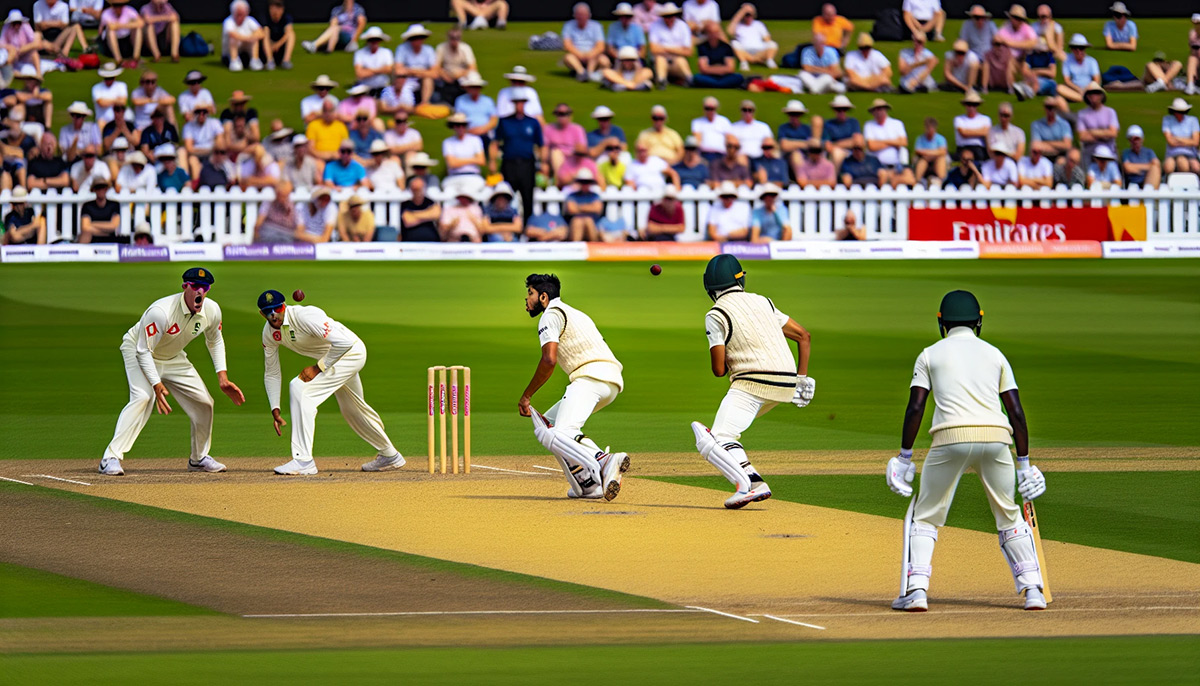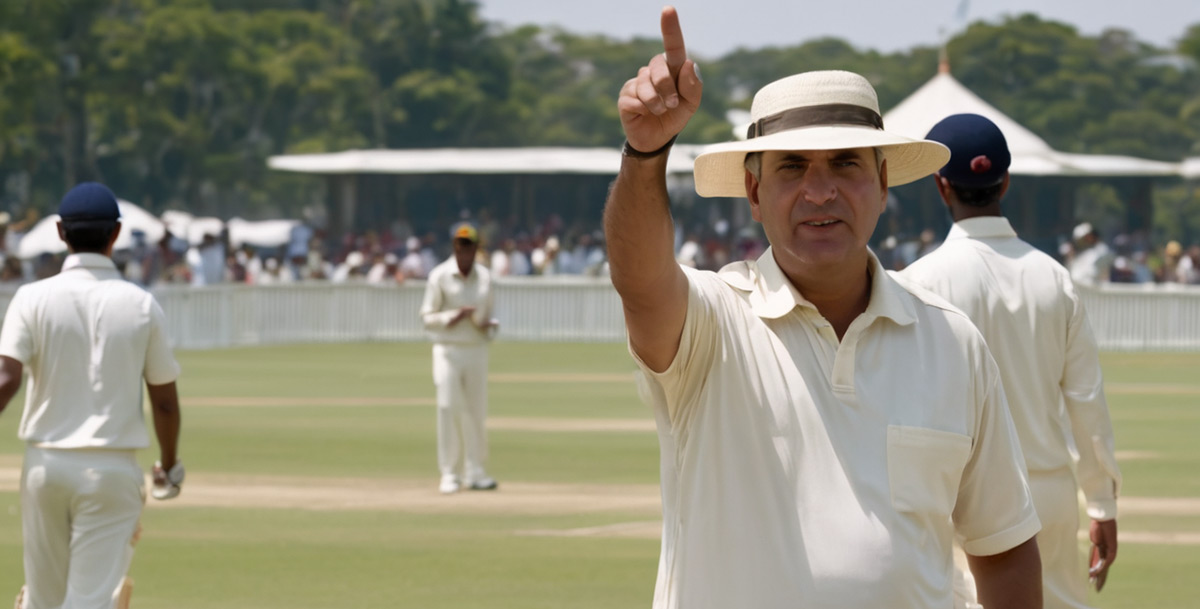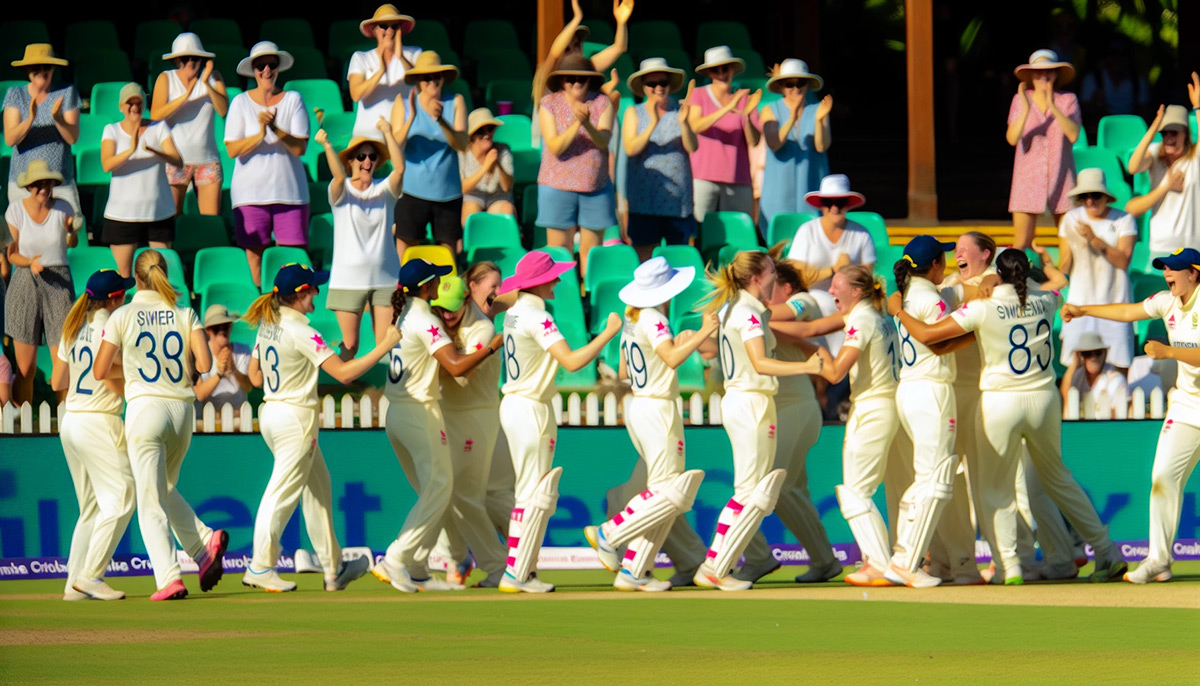Cricket is a beloved sport that may seem complicated for beginners, especially regarding the concept of innings. Don’t worry, this blog post aims to make “what is innings in cricket” easy and enjoyable for all levels of understanding!
We will delve into every aspect of innings, from their significance within the game to how they are constructed across different formats.
Whether you’re an experienced fan or simply curious about this element of cricket, join us as we decipher “what is an innings in cricket” together.
Key Takeaways
Innings in cricket are integral to the outcome of a match, with different formats having varying structures.
Test matches require strategic adjustments due to time constraints, and captains must consider declaration strategies.
Notable team and individual innings records have been set across all formats, inspiring generations of cricketers for excellence.
The Essence of Innings in Cricket

In the game of cricket, an innings refers to the period when the team batting tries to accumulate as many runs as possible.
The game's format, whether limited overs or Test cricket, can significantly affect the length and order of innings, which can determine the game's outcome.
On the other hand, the bowling team goal is to limit the scoring of the opposing team and dismiss the batsmen to curtail run-scoring opportunities.
The number of innings in a game and how they are played out depend on the strategies employed by both teams.
Success in cricket is more often determined by strategic planning than by chance.
Innings Structure in Various Cricket Formats

To fully comprehend the structure of innings in cricket, it's essential to delve into the difference between limited overs and test matches.
In Test cricket, teams can bat twice without a limit on their number of overs.
In contrast, in formats like ODIs and T20s, collectively called 'limited overs,' each team is given a specific duration to complete its bowlers' quota.
This variation has given rise to unique strategies being adopted by players based on the format they're playing.
This has introduced an intriguing dynamic between different game versions, captivating both spectators and players alike.
Limited Overs Format: One-Day Internationals (ODIs) and T20s
In limited overs formats such as ODIs and T20s, each innings is restricted to a set maximum of overs—50 in the former case, 20 for the latter.
The batting team’s challenge is scoring enough runs without losing all their wickets before reaching this limit.
Achieving a balance between aggression and calculated risks makes cricket in these shorter versions quite dynamic while necessitating tactical skill from players who need adaptability.
An innings can end either when its over quota has been met or if all 10 wickets are gone by then, whichever comes first!
Test Cricket's Unique Approach

Test cricket does not set any limitations on the number of overs. Both sides are granted two innings to bowl and bat, making it a competition requiring fortitude and serenity in its play.
The aim for batting teams is to score more runs than their adversaries via sound strikes over extended periods or multiple days.
Weather situations may disrupt the weather. Test matches by granting too little time for both squads to complete all four innings, inducing additional difficulty as strategies must be adapted based on changing climate conditions and the available hours and days left before the match's conclusion; otherwise match is declared as DRAW if no one succeeds.
The Closure of an Innings

Test matches involve careful strategic planning that requires both teams to understand the importance of completed innings. A declaration during a test match can have numerous effects on the game’s outcome, and it is, therefore, each team must consider how best they should approach this situation.
To maximize their chances of winning, teams must be aware of all elements involved with declaring an inning in Test cricket, such as reaching maximum overs or losing wickets, as these will affect the result significantly upon completion of play.
Declaration Strategy in Test Matches
Test cricket is unique because of the ability of captains to close their team’s innings strategically, set a target, or require the opposing side to follow-on. Decisions about when and how much to declare are based on the number of overs left in play, both teams’ relative strengths, pitch conditions, and desired scores.
Making an effective declaration can involve setting challenging goals for opponents, effectively managing time during matches, or taking into account environmental elements like weather patterns. Test cricket has the follow-on rule’, which allows those batting first with at least 200 runs more in the first innings than their rivals to take up second immediately. This adds another strategy layer to all games played under these regulations.
In summary, a prudent selection from the captain regarding declarations boosts strategic acuity throughout Test Cricket contests!
Objectives for the Batting Team During Their Innings
During their innings, the batting team in a cricket match has several key objectives to focus on. The primary goal is to score as many runs as possible from the cricket bat while losing as few wickets as possible. This involves a balance of aggressive and defensive play, with batsmen aiming to hit boundaries for high scores while also defending their wicket from the bowlers.
One of the critical strategies for the batting team is to manage their run rate effectively. The run rate, which is the average number of runs scored per over, is a crucial factor in deciding the outcome of the match, especially in limited-overs cricket. The batting team needs to maintain a healthy run rate to set a challenging target for the opposing team or to chase down the target set by the opposition.
Another objective for the batting team is to keep their key batsmen at the crease for as long as possible. These players, often referred to as the team's backbone, have the ability to score high and can change the course of the match with their batting prowess.
The team bats also need to be mindful of the conditions of the pitch and adjust their strategy accordingly. On a pitch favouring the bowlers, the batsmen might need to play more defensively, while on a batting-friendly pitch, they can afford to be more aggressive.
In summary, the batting team's innings in a cricket match are a strategic play of offence and defence, where the ultimate goal is to outscore the opposition while preserving their wickets.
Notable Innings Records

Team and individual accomplishments in first-class cricket are documented through impressive innings records. These benchmarks set by some of the sport’s greats motivate future generations to push their limits as cricketers. We take a closer look at these remarkable feats achieved within this realm of the game.
For both teams and individuals, noteworthy results have been attained throughout history within first-class cricket matches, exemplified through special moments showcased via incredible innings performances that will not be forgotten anytime soon.
Record-Breaking Team Innings
The sheer potency of team efforts and high-scoring games is exemplified by the records set in different forms of cricket.
In Test Cricket, for instance, Sri Lanka holds the record highest score with 952/6d achieved against India in 1997.
Likewise, England has an impressive batting feat to its name, having scored 498/4 versus the Netherlands in a one-day international match from 2022 onward.
Nepal is another shining example of high-scoring teams, particularly in T20 cricket. They have set the highest total recorded in this format's single inning 314/3 in Sep 2023.
These records are impressive for their sheer numbers and represent the extraordinary teamwork displayed during matches in various leagues worldwide!
Memorable Individual Innings
Outstanding performances by cricketers have created iconic moments in individual innings. Brian Lara is honoured to have the highest score attained in Test cricket, with an amazing 400 not out under his belt.
Rohit Sharma has claimed a record-breaking number of runs during one-day internationals. He scored 264 against Sri Lanka back in 2014.
As far as T20 is concerned, Kushal Malla from Nepal achieved the fastest century ever—34 balls!
These remarkable efforts remain part of our beloved sport’s history and serve to motivate upcoming players who seek to surpass them through higher scores and faster accomplishments on their batting displays.
Innings Terminology in Cricket
Cricket lovers are often familiar with various expressions and phrases used to express different elements of the game. Being able to understand these terms will deepen your knowledge of cricket as well as help you in conversations with other enthusiasts.
During a cricket innings, you'll often hear phrases like bye, middle order, innings, bowler, batsman, score, and run out.
Extras are runs conceded by the bowling team that aren't a result of the batting team's efforts.
The run rate is a measure of the average runs scored per over by a team.
When a batsman doesn't score any runs, it's called a 'duck', while a 'maiden over' refers to an over in which the batsman scores no runs off the bowler's deliveries.
When discussing innings in cricket, it’s important to take into account all this vocabulary due to its importance when conversing with fellow fans but also understanding each other's point of view, resulting in ultimately being fundamental so we can measure performance throughout stats while using our comprehensive comprehension built from personal passion around cricket.
The Role of Innings in Match Outcomes
The number of innings is a determining factor for the outcome of a cricket match, as each batting team needs to score enough runs in order for it to be successful.
In some cases, if they cannot do so, the batting team loses out on their chance of winning.
To optimize this process and increase expected scores, teams have created tactics like giving spin bowlers more overs or bringing key players into play during advantageous times within matches, such as Test Matches (Tests), One Day Internationals (ODIs), and Twenty20s (T20).
The length of time allotted and other differences between these three formats often results in different strategies and playing styles employed by various teams throughout competition.
Individual player performances weigh heavily when deciding an overall winner, but realizing that one unified group taking challenges together trumps all should not be forgotten.
Teamwork plays just as important a role!
Summary
Innings in cricket are an essential part of the game, playing a fundamental role in deciding its outcome. Their structure varies between formats, and the strategies teams use throughout these sessions often significantly affect matches. We have discussed all aspects of this intriguing feature. From facts about notable records to terminology related to them
We trust that you now feel better informed about innings in cricket and understand why they hold such importance when enjoying a successful match! Our aim was that the knowledge imparted here today would enhance your understanding and encourage conversations with other passionate fans who follow this cricket sport so closely.
Frequently Asked Questions
What is an innings in cricket?
In a typical game of cricket, each team gets to play two innings. An 'innings' is a phase of the game where one team bats and the other team bowls and fields. The two teams alternate between batting and bowling twice in a first-class cricket match.
How much is one inning?
Regarding Test matches, the batting team is limited by the number of batsmen they have, as there is no overlimit. The innings will continue until every player on their team has been dismissed or they decide to declare. In contrast, one-day matches are restricted, with an inning period of 50 overs lasting for 210 minutes (3 and a half hours).
What is 2nd innings in cricket?
The team batting second will take their innings after the initial team has finished theirs. This inning they are participating in would be called ‘the 2nd innings’.
How many overs are in an inning?
In cricket, an 'innings' refers to a sequence of six consecutive balls, known as 'overs'. According to the rules set by the International Cricket Council (ICC), Test matches are played over a duration of 90 overs, whereas one-day international matches are limited to 50 overs. In the case of T20 games, each innings is restricted to 20 overs.
What is the primary objective of a team during an innings in cricket?
During an innings in cricket, a team’s main goal is to accumulate as many runs through batting as possible and avoid being dismissed.
Your email address cannot be published. Required fields are marked*

 My Account
My Account Track Order
Track Order Sports Guide
Sports Guide